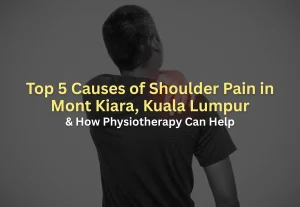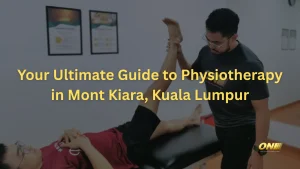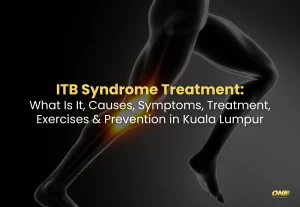Introduction
A meniscus tear is one of the most common knee injuries, often resulting in pain, swelling, and restricted movement. Understanding the condition is the first step to recovery. Whether you’re an athlete, an active adult, or someone simply managing the effects of aging, this guide will help you understand the causes, symptoms, and treatments for meniscus tears.
At ONI Physio Fitness, we specialize in helping individuals recover from meniscus tears with targeted physiotherapy. Learn how you can regain mobility and get back to your favorite activities, pain-free.
What Is a Meniscus Tear?

The meniscus is a crescent-shaped piece of cartilage located in the knee joint. It acts as a natural shock absorber and helps stabilize the joint by distributing weight evenly.
Each knee contains two menisci:
- Medial Meniscus: Located on the inside of the knee.
- Lateral Meniscus: Located on the outside of the knee.
A tear can occur in different parts of the meniscus, such as the outer edge (more vascular and healable) or the inner section (less vascular and harder to heal). Tears vary in size and pattern, including horizontal, vertical, or bucket-handle tears.
What Causes a Meniscus Tear?
Here’s a detailed breakdown of common causes:
Sudden Twisting Movements
Activities like pivoting quickly or abrupt directional changes during sports (e.g., football, basketball, or tennis) can strain the meniscus, leading to tears.

Direct Trauma
A forceful impact to the knee, such as during a tackle or a fall, can damage the cartilage.
Degenerative Changes with Age
Over time, the meniscus becomes less elastic and more prone to wear and tear. This explains why older individuals can tear a meniscus during simple actions like kneeling or stepping awkwardly.
Improper Body Mechanics
Incorrect squatting or lifting heavy objects can place excessive pressure on the knees.
Symptoms of a Meniscus Tear
- Knee Pain
Pain may occur on one side of the knee or all around the joint, depending on the tear’s location. It typically worsens during twisting motions or squatting. - Swelling and Stiffness
Swelling can develop within hours or even days after the injury. This is due to inflammation or fluid buildup in the knee. - Locking Sensation
A torn piece of cartilage may catch in the joint, preventing the knee from fully straightening. - Popping Sensation
Many individuals recall hearing or feeling a “pop” at the time of injury, which may indicate a tear. - Limited Range of Motion
Moving the knee may feel uncomfortable or impossible without significant effort.
Common Populations with Meniscus Tears
While meniscus tears can happen to anyone, they’re more frequent in:
- Athletes:
Sports requiring quick starts, stops, and pivots increase the risk of tears. - Older Adults:
Degenerative changes in cartilage with age make tears more likely. - Active Adults:
Activities like jogging or heavy lifting can strain the knees. - People with Knee Osteoarthritis:
Joint degeneration weakens cartilage, increasing susceptibility.
How to Treat a Meniscus Tear?
The appropriate treatment depends on the severity of the injury:
Physiotherapy
At ONI Physio Fitness, we use a combination of techniques:
- Manual Therapy: Gentle mobilization to reduce stiffness and discomfort.
- Strengthening Exercises: Builds muscle support around the knee.
- Rehabilitation Guidance: Helps restore range of motion safely.
Medications
NSAIDs (non-steroidal anti-inflammatory drugs) help reduce inflammation. (Please consult a professional doctor before taking any medication)
Surgical Intervention
In severe cases, surgery (e.g., arthroscopic repair or meniscectomy) may be necessary.
Exercises for Meniscus Tear
Straight Leg Raises
- Lie flat on your back, keeping one leg bent with the foot flat on the floor.
- Straighten the other leg and slowly lift it about 30 cm off the ground.
- Hold for 5 seconds and lower it slowly.
- Repetitions: 10-15 per leg.
Mini Squats
- Stand with feet shoulder-width apart, keeping your back straight.
- Slowly lower yourself by bending your knees slightly, like you’re sitting back into a chair.
- Stop at a 30-degree bend, then return to standing.
- Repetitions: 10-12.
Heel Slides
- Sit or lie on your back with your legs extended.
- Slowly slide your heel toward your buttock while keeping the other leg straight.
- Slide it back to the starting position.
- Repetitions: 10 per leg.
Calf Raises
- Stand straight with your hands on a wall or chair for balance.
- Slowly rise onto your toes, lifting your heels off the ground.
- Lower yourself back down.
- Repetitions: 10-15.
Prevention of Meniscus Tears
- Strength Training
Target muscles around the knee, especially the quadriceps and hamstrings, to stabilize the joint. - Stretching and Flexibility
Include regular stretches to maintain joint mobility and reduce stiffness. - Proper Technique
Use correct form during activities like lifting or squatting. - Supportive Footwear
Wear shoes with good arch support to distribute weight evenly across the knees. - Listen to Your Body
Avoid pushing through knee pain during activities; take rest when needed.
Conclusion
A meniscus tear can be challenging, but with timely care and rehabilitation, you can regain your mobility and strength. Physiotherapy is a non-invasive, effective treatment option that addresses pain, restores range of motion, and prevents future injuries.
At ONI Physio Fitness, we specialize in personalized care for meniscus tears, serving Mont Kiara, Kuala Lumpur, and nearby areas like Petaling Jaya and Sri Hartamas.
Book an appointment today, and let us help you get back to doing what you love, pain-free!
















